

Designation:MDR-17 Unicorn
|
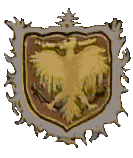
|
||||
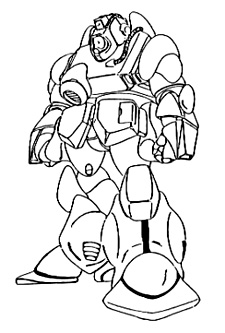
|
|||||
| • | Total Height | : | 6.2 m | |
| • | Total Depth | : | 2.6 m | |
| • | Total Breadth | : | 3.0 m | |
| • | Weight | : | 13.2 metric tons |
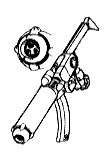
Optional hand-held gun pods:
|

|
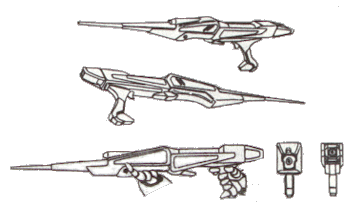
|
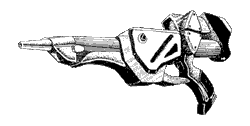
|
|
The armor on the Unicorn is a new development in low-mass composite-materials Chobham plating that became the standard for all Terran mecha after its application to the VQ-6A Vandal. Aside from the respectable protection provided against projectiles, missiles, and other kinetic weapons, this armor is also resistant to plasma globes (annihilation discs), lasers, and to a lesser extent, particle guns, owing to the fact that the armor can flake off and evaporate in layers under fire from such high-energy weapons, taking much of the weapon's energy and converting it into the latent heat of sublimation in the armor. The armor stops all small arms, heavy infantry weapons fire, and light mecha-mounted weaponry, provides fair to good resistance to medium mecha-mounted weaponry, such as the Valkyrie's 55mm APFSDS round, and provides poor resistance to heavy mecha-mounted weaponry, such as the VHT-2's 120mm shell.
The Unicorn provides full protection from nuclear, biological, and chemical hazards, using a fully-sealed cockpit module activated by radiation and hazardous chemical sensors, or manually when biological warfare conditions are anticipated. The cockpit module is also armored and gives the Unicorn the option of operating off-planet on the moon or elsewhere in the system. The internal consumables supplies can provide atmosphere purification for one week maximum on Earth and 48 hours in a hostile environment such as the moon or Mars.
The Southern Cross Surface Command decided that the large vintage destroids were too conspicuous and vulnerable to standoff missile attacks to be fully effective. Also, in urban combat, the huge robots could easily lose small vehicles in back streets that were too small to accommodate the large destroids. As such, they desired to create a smaller and more agile mecha that could better adapt to a variety of operating environments. From this desire, the battloid concept evolved: a smaller, more agile, multi-purpose robot. To decrease the size and provide operational flexibility, the primary weapons shifted to an assortment of gunpods instead of the slow to reload integral weapons. The Unicorn retained an integral laser weapon so that the power of the mecha's protoculture energizer could be tapped to supply the demand of the anti-missile air defense laser, as well as a pair of grenade launchers for self-defense and secondary missions. It was also beneficial that the smaller battloids were much simpler and cheaper to manufacture allowing the depleted Southern Cross armies to rapidly rebuild a cohesive fighting force after being depleted by the departure of the Pioneer mission and their appropriation of most of Earth's mecha forces.
The Unicorn was developed for multi-purpose urban and base defense. The Unicorn was developed as a low-observability anti-missile defense mecha to fulfill that portion of the mission profile of the ADR-04 Defender destroid, as well as for riot control use to combat fear of mass hysteria with the exodus of the REF Pioneer mission containing a large segment of the Robotech mecha of the time. In peacetime, this mecha was also used in a fire suppression role. It could perform construction and fire suppression duties as well as its primary air defense and riot control roles. While less armed than the Defender, it was hoped that the smaller size and greater agility would offset this provided sufficient numbers of Unicorns were available. Also, due to the short range of the Unicorn's radar systems, it relies on linkage of surveillance data from air defense radars or forward observation mecha to provide comparable range to the Defender.
The Unicorn is equipped with rubber soles and large feet to minimize damage to city streets and sidewalks by spreading the force as much as possible. The Gunpod and grenade launcher ammunition would be changed depending on the unit's mission. For peace-time duties, mostly tear gas and smoke gas were used with some fire abatement loads also, in addition to the FU-1 water cannon. For combat duties, more offensive grenade rounds were loaded.
Most of the Unicorns were destroyed valiantly defending their posts against the initial Invid onslaught.
See additional design notes.
Return to Southern Cross Mecha Index.
Go to Robotech Reference Guide Home Page.
Robotech (R) is the property of Harmony Gold. This document is in no way intended to infringe upon their rights.
Content by Rob Morgenstern, with Pieter Thomassen, Tim Wing and Peter Walker